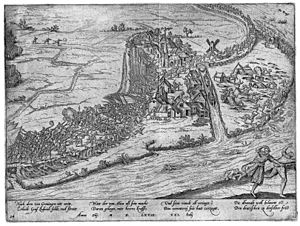Battle of Jemmingen facts for kids
Quick facts for kids Battle of Jemmingen |
|||||||
|---|---|---|---|---|---|---|---|
| Part of the Eighty Years' War | |||||||
 The Battle of Jemmingen by Frans Hogenberg. |
|||||||
|
|||||||
| Belligerents | |||||||
| Dutch rebels | |||||||
| Commanders and leaders | |||||||
| Louis of Nassau | Duke of Alba | ||||||
| Strength | |||||||
| 10,000 infantry 2,000 cavalry 16 guns |
12,000 infantry 3,000 cavalry |
||||||
| Casualties and losses | |||||||
| 7,000 dead or wounded | 80 dead 220 wounded |
||||||
The Battle of Jemmingen (also called the Battle of Jemgum) was an important battle during the Eighty Years' War. This war was fought between the Netherlands (Dutch rebels) and Spain. The battle happened on 21 July 1568 in a place called Jemmingen, which is now part of Germany. It was a big victory for the Spanish army.
Before this battle, a Dutch rebel leader named Louis of Nassau had won a fight at Heiligerlee. Louis was the brother of William the Silent, another important Dutch leader. After his victory, Louis tried to capture the city of Groningen, but he failed. The Spanish army, led by the Duke of Alba, then chased Louis's forces. This led to the Battle of Jemmingen.
Who Fought in the Battle?
The Spanish army was very strong. They had about 12,000 foot soldiers, called infantry. Many of these soldiers were part of special Spanish army units called tercios. They also had 3,000 cavalry, who were soldiers on horseback, and some cannons.
Louis of Nassau's Dutch rebel army was a bit smaller. They had about 10,000 foot soldiers and some cavalry. They also had more cannons than the Spanish, with 16 guns.
How the Battle Unfolded
The battle started with about three hours of small fights and clashes between the two armies. These are called skirmishes. After a while, Louis's army decided to leave their protected positions and move forward to attack.
However, the Spanish soldiers were very good with their muskets, which were a type of gun. They fired effectively at the advancing Dutch rebels. The Spanish cavalry also made the Dutch army feel scared and unsure. Because of the strong Spanish attack, the Dutch advance quickly turned into a full retreat. Louis's soldiers ran back towards the Ems River.
What Happened After the Battle?
The Battle of Jemmingen was a huge defeat for the Dutch rebels. Many of Louis of Nassau's soldiers were killed or wounded. The Spanish army, however, had very few losses. This battle showed the strength of the Spanish army at that time.
Years later, in 1571, a statue of the Duke of Alba was made. It was created from some of the bronze cannons that the Spanish had captured from the Dutch rebels during the battle. This statue was placed in the city of Antwerp. However, in 1576, the city of Antwerp joined the Dutch Revolt against Spain. An angry crowd then destroyed the Duke's statue in 1577.
See also
 In Spanish: Batalla de Jemmingen para niños
In Spanish: Batalla de Jemmingen para niños

